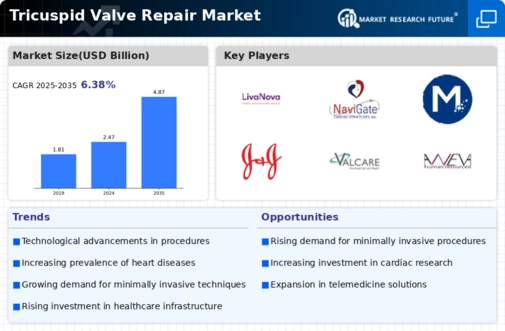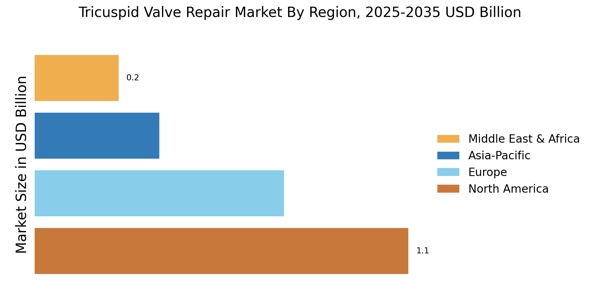Increased Awareness and Education
The rising awareness and education regarding heart health are pivotal in driving the Tricuspid Valve Repair Market. Campaigns aimed at educating the public about the symptoms and risks associated with tricuspid valve disorders are becoming more prevalent. This increased awareness is likely to lead to earlier diagnosis and treatment, which is crucial for effective management of these conditions. Moreover, healthcare professionals are receiving enhanced training on the latest treatment modalities, which could further improve patient outcomes. As patients become more informed about their treatment options, the demand for tricuspid valve repair procedures is expected to rise. This trend indicates a positive trajectory for the Tricuspid Valve Repair Market, as more individuals seek timely interventions for their heart conditions.
Advancements in Surgical Techniques
Innovations in surgical techniques are transforming the landscape of the Tricuspid Valve Repair Market. Minimally invasive procedures, such as transcatheter approaches, are gaining traction due to their reduced recovery times and lower complication rates. These advancements not only enhance patient outcomes but also expand the range of patients eligible for repair procedures. Recent data indicates that minimally invasive techniques can reduce hospital stays by up to 50%, which is appealing to both patients and healthcare providers. As surgical techniques continue to evolve, the Tricuspid Valve Repair Market is likely to experience increased adoption of these advanced methods, leading to a surge in market growth. The ongoing research and development in this area may further refine these techniques, potentially increasing their effectiveness and safety.
Technological Innovations in Medical Devices
Technological innovations in medical devices are significantly influencing the Tricuspid Valve Repair Market. The development of advanced materials and devices, such as bioprosthetic valves and innovative suturing techniques, is enhancing the efficacy of tricuspid valve repair procedures. These innovations not only improve the durability of repairs but also reduce the risk of complications. Recent advancements in imaging technologies, such as 3D echocardiography, are facilitating more accurate assessments of valve conditions, leading to better surgical outcomes. As these technologies continue to evolve, they are likely to attract more healthcare providers to adopt tricuspid valve repair solutions. The ongoing integration of technology into the medical field suggests a promising outlook for the Tricuspid Valve Repair Market, as it aligns with the growing demand for effective and safe treatment options.
Rising Incidence of Tricuspid Valve Disorders
The increasing prevalence of tricuspid valve disorders is a primary driver for the Tricuspid Valve Repair Market. Conditions such as tricuspid regurgitation and stenosis are becoming more common, particularly among the aging population. According to recent estimates, the incidence of tricuspid regurgitation is projected to rise significantly, with a notable increase in cases among individuals over 65 years of age. This demographic shift is likely to create a heightened demand for effective repair solutions, thereby propelling market growth. Furthermore, as awareness of heart valve diseases increases, more patients are seeking treatment options, which could further stimulate the Tricuspid Valve Repair Market. The combination of an aging population and rising awareness suggests a robust market potential for tricuspid valve repair solutions.
Growing Investment in Healthcare Infrastructure
The expansion of healthcare infrastructure is a significant driver for the Tricuspid Valve Repair Market. Governments and private entities are increasingly investing in healthcare facilities, particularly in regions with a high burden of cardiovascular diseases. This investment is aimed at improving access to advanced medical technologies and surgical procedures. For instance, the establishment of specialized cardiac centers is expected to enhance the availability of tricuspid valve repair services. As healthcare systems evolve, the integration of cutting-edge technologies and skilled professionals will likely lead to improved patient outcomes. Consequently, this trend may stimulate demand for tricuspid valve repair solutions, thereby fostering growth within the Tricuspid Valve Repair Market. The focus on enhancing healthcare infrastructure suggests a promising future for the market.


















Leave a Comment